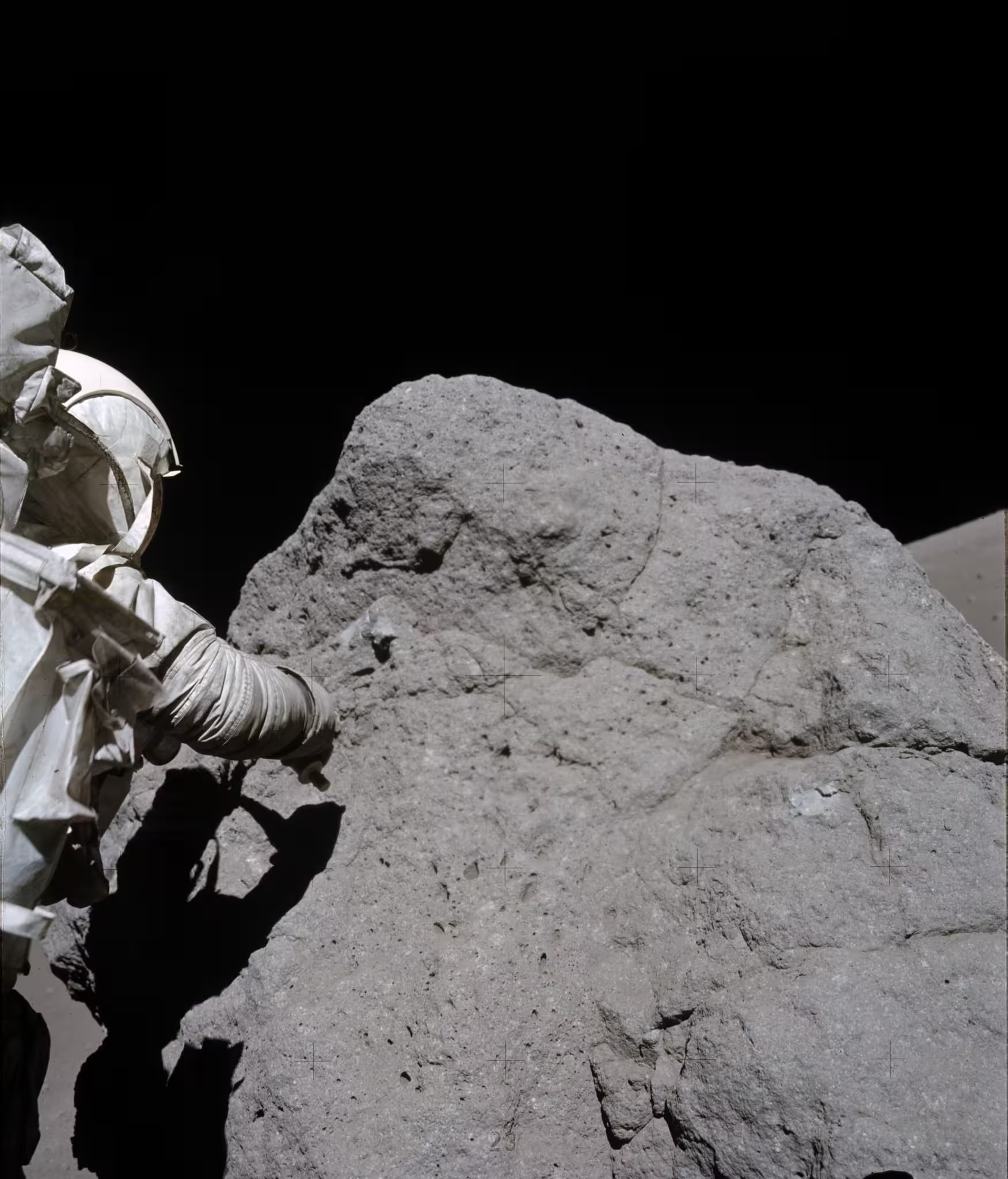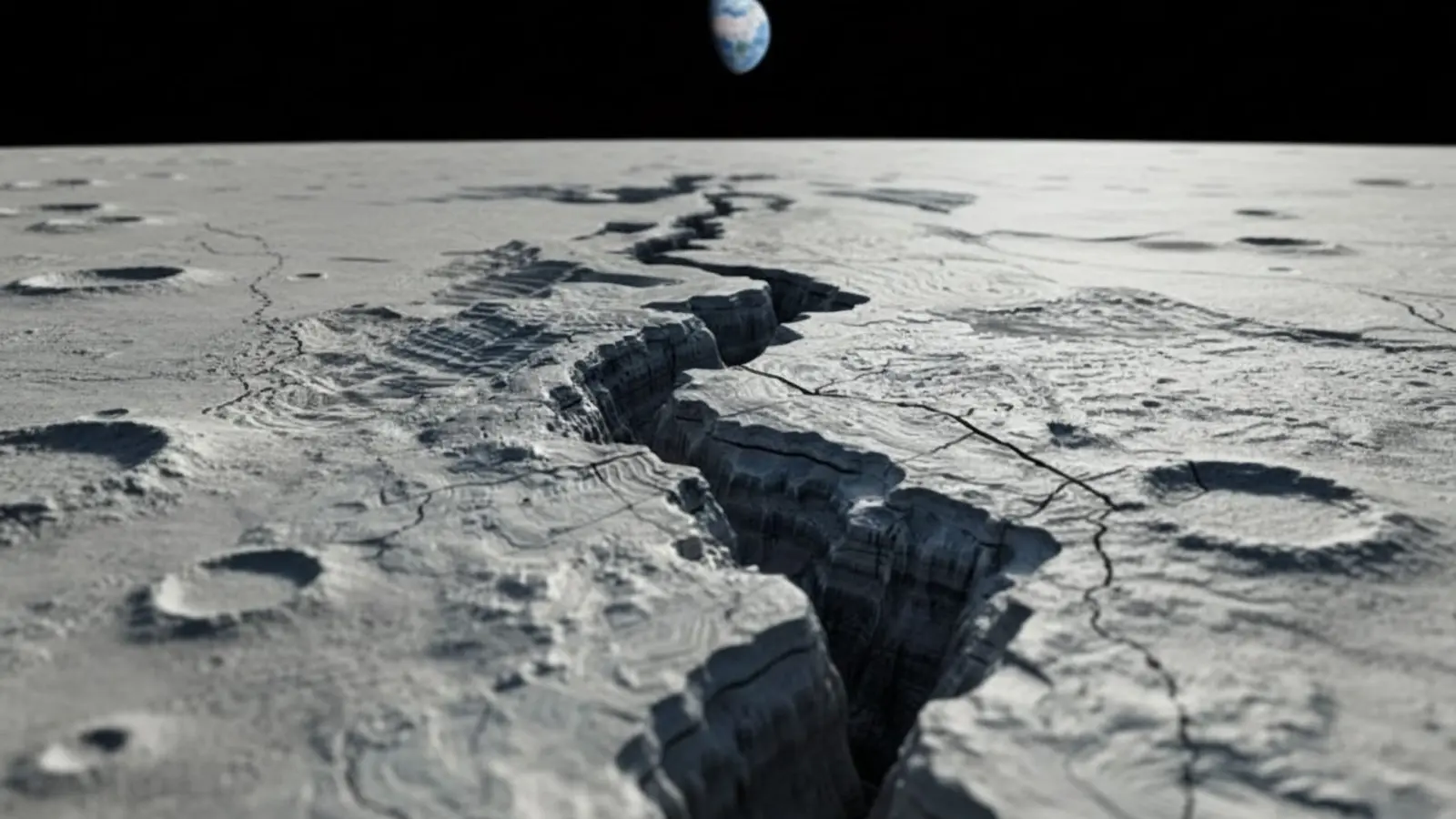8 Minutes
Moonquakes reshape the lunar landscape and pose infrastructure risks
A new analysis of geological evidence from the Apollo 17 landing site shows that recurring, low-magnitude lunar tremors — not meteorite strikes — have repeatedly altered the surface in the Taurus-Littrow valley. The study, published in Science Advances by Smithsonian Senior Scientist Emeritus Thomas R. Watters and University of Maryland geologist Nicholas Schmerr, combines field observations from Apollo samples with modern seismic modeling to assess how shallow moonquakes can displace boulders, trigger landslides, and endanger long-duration missions.
Using rock distributions and landslide deposits sampled by Apollo 17 astronauts, the team estimated the size and source of the seismic events that moved large boulders across the valley floor. Because the Moon lacks a modern, dense network of strong-motion seismic instruments, researchers must infer past ground motion from geomorphic markers: toppled boulders, disrupted slopes, and other physical traces preserved for millions of years. By coupling those observations with numerical wave-propagation models, the authors identified a likely fault source for the observed disturbances and quantified the ground motion that such faults can produce.
Geological evidence points to the Lee-Lincoln fault
The study links repeated terrain modification in Taurus-Littrow to the Lee-Lincoln fault — a shallow thrust fault crossing the valley floor. The researchers conclude that a series of relatively small but locally strong quakes, roughly around magnitude 3 as measured on Earth, have shaken the area intermittently over the past ~90 million years. On Earth a magnitude-3 event is minor, but when such a quake occurs very close to a structure or a steep slope, it can generate enough acceleration to mobilize boulders and induce slope failure.
A computer simulation depicting the seismic waves emanating from a shallow moonquake occurring on the Lee-Lincoln scarp in the Taurus-Littrow Valley on the Moon and interacting with the Apollo 17 Lunar Module landing site. The audio is the corresponding vertical ground motion from the simulation. Both audio and video are sped up by a factor of 10. The background image is a globe mosaic image from the Lunar Reconnaissance Orbiter Camera Wide Angle Camera (LROC-WAC). Red and blue are positive (upward ground motion) and negative (downward ground motion) polarities of the wave. Credit: University of Maryland, Nicholas Schmerr
The modeling indicates that shallow thrust faults, distributed globally across the lunar surface, are capable of producing localized ground accelerations that are larger than previously assumed for such small magnitudes. The Lee-Lincoln fault is one example; the Moon hosts thousands of similar faults created by planetary cooling and contraction, and new faults can form as the interior continues to adjust. The authors therefore argue that active or recently active scarps should be treated as potential seismic hazards.
Quantifying seismic risk for lunar operations
Watters and Schmerr present probabilistic estimates of seismic risk near active thrust faults. They calculate that the daily chance of a potentially damaging moonquake occurring adjacent to an active scarp is about 1 in 20 million. That probability is low on any single day, but when multiplied across long-duration missions the cumulative risk becomes appreciable. For example, a decade-long surface habitat would face an aggregate probability of experiencing a hazardous event on the order of 1 in 5,500 according to the authors’ simple cumulative model.
The practical implication is that short sorties like Apollo-era missions had negligible exposure to seismic hazards, while permanent bases, lunar habitats, and tall, high-aspect-ratio landers (including designs such as Starship-derived human landing systems) could be more vulnerable to ground acceleration. Structures with high centers of mass or narrow footprints could tip or suffer mission-critical damage if a nearby shallow quake produces a strong impulse. The team therefore recommends factoring paleoseismic evidence, scarp mapping, and local seismic hazard into landing site selection and habitat placement.
Lunar paleoseismology: methods and future instruments
Because the Moon’s seismic network is sparse and Apollo-era seismometers lacked the sensitivity of modern instruments, paleo-seismologists rely on indirect evidence. Schmerr and colleagues used geomorphic proxies — boulder falls and landslide deposits — to infer past ground motion and then tested those inferences against physics-based seismic wave models. This approach, sometimes called lunar paleoseismology, combines field geology, orbital imagery, laboratory sample analysis, and numerical simulation.
Future Artemis missions and planned orbital and surface campaigns present a strong opportunity to advance the field. New, modern seismometers with decades of technological progress over Apollo instruments will measure seismicity across frequency bands and distances not previously resolved on the Moon. High-resolution orbital imaging and laser altimetry will also permit more accurate mapping of scarps and recent slope activity, improving hazard maps for mission planners.
“If we want durable bases on the Moon, we must integrate seismic hazard assessment into site selection and engineering,” said Nicholas Schmerr. “Avoiding construction directly on active scarps and keeping habitats well away from mapped thrust faults reduces risk substantially.”
Expert Insight
"The study underscores how planetary cooling and the resulting tectonic stresses continue to shape the lunar surface on human timescales," says Dr. Elena Ruiz, a structural geophysicist at a major space agency (comment provided for context). "For engineers, the takeaway is straightforward: choose flatter, geologically older ground for long-term infrastructure, design for asymmetric ground accelerations, and invest in distributed seismic monitoring. Those steps will make Artemis-era habitats far more resilient."

Apollo 17 Astronaut Harrison H. Schmitt samples the boulder at Station 7 located at the base of North Massif in the Taurus-Littrow valley. This large boulder was dislodged by a strong moonquake that occurred about 28.5 million year ago. The source of the quake was likely from an event on the Lee-Lincoln fault. Credit: NASA/JSC/ASU
Implications for mission planning and engineering
In practical terms, mission architects and surface-habitat designers should incorporate the following into planning: seismic hazard mapping based on scarps and paleoseismic evidence, siting restrictions to keep critical assets off or distant from active thrust faults, foundation and damping systems that reduce tipping risk for tall landers and towers, and deployment of dense seismometer networks early in base operation to monitor ongoing activity. Risk is never zero, but engineering choices can reduce the likelihood and consequences of damaging moonquakes.
The authors emphasize that their results do not imply the Moon is seismically violent; rather, localized shallow quakes are a measurable hazard for permanent installations. Short-term crewed missions remain low risk, but the calculus changes when habitat lifetimes extend across years or decades.
Conclusion
The new study by Watters and Schmerr opens a practical pathway for integrating lunar paleoseismology into the planning of Artemis-era and commercial lunar missions. By using geological markers from Apollo together with modern seismic models, the work identifies active shallow thrust faults — like the Lee-Lincoln scarp in Taurus-Littrow — as credible sources of ground shaking that can mobilize boulders and threaten infrastructure. For long-term bases, the recommendations are clear: avoid recent scarps, prioritize seismic monitoring, and design landers and habitats with asymmetric ground acceleration and tipping resistance in mind. As seismometers and orbital datasets improve, lunar seismic hazard assessments will become more precise, enabling safer and more resilient human operations on the Moon.
Source: scitechdaily


Leave a Comment